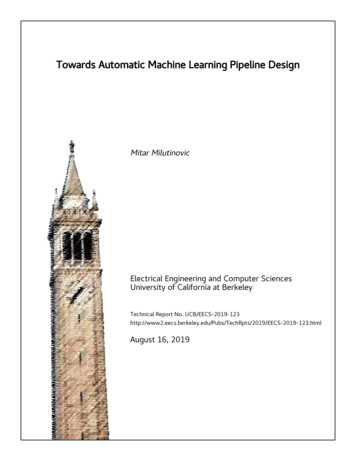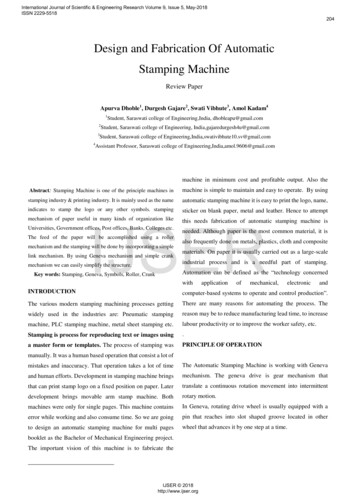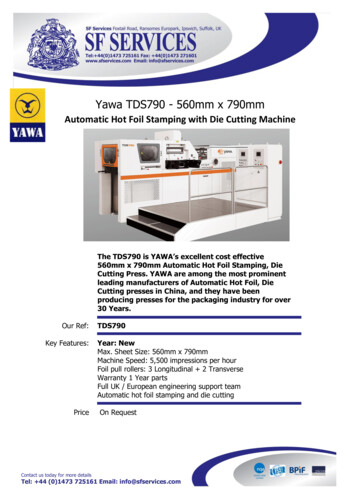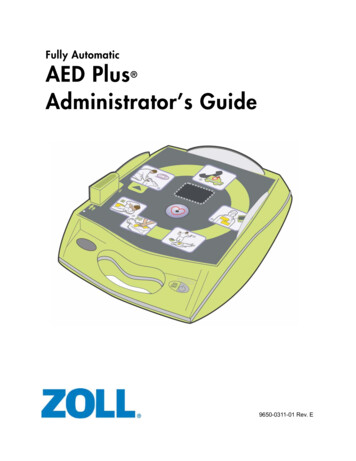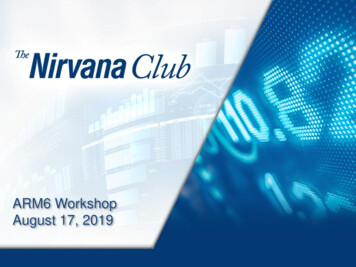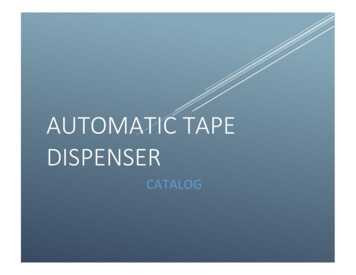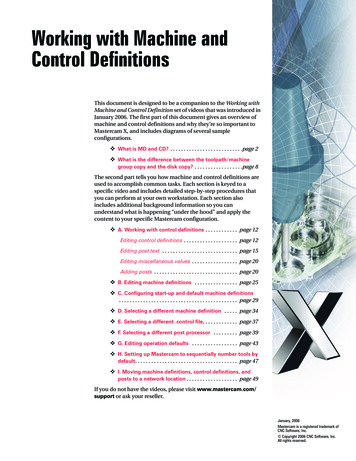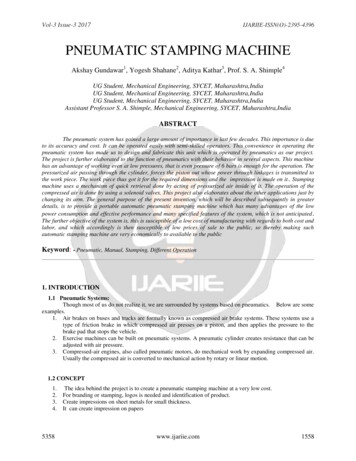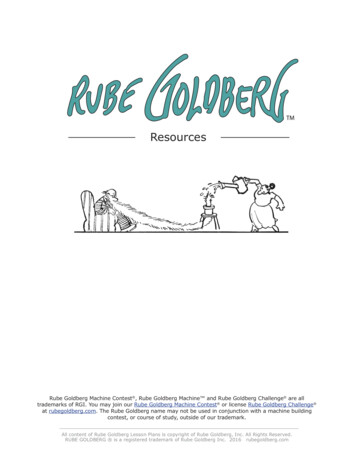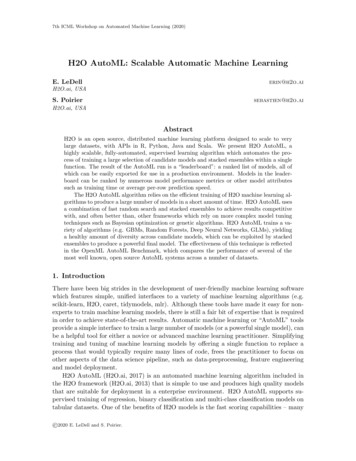
Transcription
7th ICML Workshop on Automated Machine Learning (2020)H2O AutoML: Scalable Automatic Machine LearningE. LeDellerin@h2o.aiH2O.ai, USAS. Poiriersebastien@h2o.aiH2O.ai, USAAbstractH2O is an open source, distributed machine learning platform designed to scale to verylarge datasets, with APIs in R, Python, Java and Scala. We present H2O AutoML, ahighly scalable, fully-automated, supervised learning algorithm which automates the process of training a large selection of candidate models and stacked ensembles within a singlefunction. The result of the AutoML run is a “leaderboard”: a ranked list of models, all ofwhich can be easily exported for use in a production environment. Models in the leaderboard can be ranked by numerous model performance metrics or other model attributessuch as training time or average per-row prediction speed.The H2O AutoML algorithm relies on the efficient training of H2O machine learning algorithms to produce a large number of models in a short amount of time. H2O AutoML usesa combination of fast random search and stacked ensembles to achieve results competitivewith, and often better than, other frameworks which rely on more complex model tuningtechniques such as Bayesian optimization or genetic algorithms. H2O AutoML trains a variety of algorithms (e.g. GBMs, Random Forests, Deep Neural Networks, GLMs), yieldinga healthy amount of diversity across candidate models, which can be exploited by stackedensembles to produce a powerful final model. The effectiveness of this technique is reflectedin the OpenML AutoML Benchmark, which compares the performance of several of themost well known, open source AutoML systems across a number of datasets.1. IntroductionThere have been big strides in the development of user-friendly machine learning softwarewhich features simple, unified interfaces to a variety of machine learning algorithms (e.g.scikit-learn, H2O, caret, tidymodels, mlr). Although these tools have made it easy for nonexperts to train machine learning models, there is still a fair bit of expertise that is requiredin order to achieve state-of-the-art results. Automatic machine learning or “AutoML” toolsprovide a simple interface to train a large number of models (or a powerful single model), canbe a helpful tool for either a novice or advanced machine learning practitioner. Simplifyingtraining and tuning of machine learning models by offering a single function to replace aprocess that would typically require many lines of code, frees the practitioner to focus onother aspects of the data science pipeline, such as data-preprocessing, feature engineeringand model deployment.H2O AutoML (H2O.ai, 2017) is an automated machine learning algorithm included inthe H2O framework (H2O.ai, 2013) that is simple to use and produces high quality modelsthat are suitable for deployment in a enterprise environment. H2O AutoML supports supervised training of regression, binary classification and multi-class classification models ontabular datasets. One of the benefits of H2O models is the fast scoring capabilities – many 2020 E. LeDell and S. Poirier.
E. LeDell and S. PoirierH2O models can generate predictions in sub-millisecond scoring times. H2O AutoML offersAPIs in several languages (R, Python, Java, Scala) which means it can be used seamlesslywithin a diverse team of data scientists and engineers. It is also available via a point-andclick H2O web GUI called Flow1 , which further reduces the barriers to widespread use ofautomatic machine learning. H2O also has tight integrations to big data computing platforms such as Hadoop2 and Spark3 and has been successfully deployed on supercomputers4in a variety of HPC environments (e.g. Slurm).The H2O AutoML algorithm was first released in June, 2017 in H2O v3.12.0.1 so it hasgone through many iterations of development over the past three years. It is widely usedin industry and academia and has many advocates in the open source machine learningcommunity. The algorithm is constantly evolving and improving in each new version ofH2O, so this paper serves as a snapshot of the algorithm in time (May, 2020). A full list ofin-development and planned improvements and new features is available on the H2O bugtracker website.52. H2O AutoMLH2O AutoML is a fully automated supervised learning algorithm implemented in H2O, theopen source, scalable, distributed machine learning framework. H2O AutoML is availablein Python, R, Java and Scala as well as through a web GUI. Though the algorithm is fullyautomated, many of the settings are exposed as parameters to the user, so that certainaspects of the modeling steps can be customized.2.1 Data pre-processingH2O AutoML currently provides the same type of automatic data-preprocessing that’sprovided by all H2O supervised learning algorithms. This includes automatic imputation,normalization (when required), and one-hot encoding for XGBoost models. H2O tree-basedmodels (Gradient Boosting Machines, Random Forests) support group-splits on categoricalvariables, so categorical data can be handled natively. In experimental versions of thealgorithm, we have benchmarked various automatic target encoding6 strategies for highcardinality features, though that’s not yet available in the current stable release (H2Ov3.30.0.3). Additional data pre-processing steps such as automatic text encoding usingWord2Vec7 , as well as feature selection and feature extraction for automatic dimensionalityreduction are all part of the H2O AutoML a.atlassian.net/issues/?filter c.html2
H2O AutoML2.2 Models2.2.1 Base ModelsH2O AutoML includes XGBoost Gradient Boosting Machines (GBM)8 , as well as H2O Gradient Boosting Machines (GBM)9 , Random Forests10 (Default and Extremely RandomizedTree variety), Deep Neural Networks11 and Generalized Linear Models (GLM)12 . H2O offersa wrapper around the popular XGBoost software, so we are able to include this third-partyalgorithm in H2O AutoML. This also allows GPU acceleration of training.The current version of H2O AutoML (H2O v3.30.0.3) trains and cross-validates (whennfolds 1) models: three pre-specified XGBoost GBM models, a fixed grid of H2O GLMs,a default H2O Random Forest (DRF), five pre-specified H2O GBMs, a near-default H2ODeep Neural Net, an H2O Extremely Randomized Trees (XRT) model, a random grid ofXGBoost GBMs, a random grid of H2O GBMs, and a random grid of H2O Deep Neural Nets.For each algorithm, we identified which hyperparamters we consider to be most important,defined ranges for those parameters and utilize random search to generate models. A list ofthe hyperparameters and the ranges we explored for each algorithm in the H2O AutoMLprocess is documented in the user guide.13 Which hyperparamters to consider, as well astheir ranges, were decided upon based on benchmarking as well as the experience of expertdata scientists (e.g. Kaggle Grandmasters14 ), and this is something we consistently try toimprove upon over time via extensive benchmarking.The pre-specified models are included to give quick, reliable defaults for each algorithm.The order of the algorithms, which can be customized by the user, is set to start with modelsthat consistently provide good results (pre-specified XGBoost models) across a wide varietyof datasets, followed by a tuned GLM for a quick reference point. From here we prioritizeincreasing the diversity across our set of models (for the sake of the final Stacked Ensembles)by introducing a few Random Forests, (H2O) GBM and Deep Learning models. After thisset of prescribed models is trained and added to the leaderboard, we begin a randomsearch across those same algorithms. The proportion of time spent on each algorithm inthe AutoML run is explicitly defined to give some algorithms (e.g. XGBoost GBM, H2OGBM) more time than others (e.g. H2O Deep Learning), according to our perceived orestimated “value” of each task. In H2O v3.30.0.1, we introduced an experimental parameter,exploitation ratio, which, if activated, fine-tunes the learning rate of the best XGBoostGBM model and best H2O GBM model and if a better model is found, adds it to theleaderboard.2.2.2 Stacked EnsemblesAfter training the base models, two Stacked Ensemble models are trained using H2O’sStacked Ensemble algorithm15 . Stacked Ensembles, also called Stacking or Super cience/stacked-ensembles.html3
E. LeDell and S. Poirieris a class of algorithms that involves training a second-level metalearner to find the optimalcombination of the base learners. Stacked Ensembles perform particularly well if the basemodels are individually strong and make uncorrelated errors. Random search across avariety of algorithm families produces a very diverse set of base models, and when pairedwith stacking, produces powerful ensembles.The All Models ensemble contains all the models, and the Best of Family ensemblecontains the best performing model from each algorithm class/family. In particular, thatincludes one XGBoost GBM, H2O Random Forest, H2O Extremely Randomized Tree Forest, H2O GBM, H2O Deep Learning, and H2O GLM model. The Best of Family ensembleis optimized for production use cases since it only contains six (or fewer) base models andcan generate predictions rapidly compared the All Models ensemble. The Best of Familyensemble will usually have slightly lower model performance, however it’s usually still ajump in performance over the top base model. Generally, both of the ensembles producebetter models than any individual model from the AutoML run, however in rare cases,models such as a simple GLM can rise to the top of the leaderboard.By default, the metalearner in the Stacked Ensemble will be trained using the k -foldcross-validated predictions from the base learners. This version of stacking is called theSuper Learner algorithm (Laan et al., 2007) and has been proven to represent an asymptotically optimal system for learning. In cases where the data is very large or there is atime-dependency across rows in the data, it is not advised to use cross-validation. Useof a holdout blending frame is the recommended way to train a Stacked Ensemble in thisscenario (described in Appendix C).2.3 APIThe H2O AutoML interface is designed to have as few parameters as possible so that allthe user needs to do is point to their dataset, identify the response column and optionallyspecify a time constraint or limit on the number of total models trained.Python and R interfaces:aml H2OAutoML(max runtime secs 3600)aml.train(y "response colname", training frame train)aml - h2o.automl(y "response colname", training frame train,max runtime secs 3600)In both the R and Python API, H2O AutoML uses the same data-related arguments,as the other H2O algorithms (e.g. x, y, training frame). The user can configure valuesfor max runtime secs and/or max models to set explicit time or number-of-model limitson your run. The only required user-defined parameters of H2O AutoML are the dataspecification. If a stopping criteria (max runtime secs and/or max models), is not set bythe user, the AutoML run will execute for 1 hour. For Python users, there is also scikit-learncompatible API for H2O AutoML16 included in the H2O python package, which exposesthe standard scikit-learn methods (e.g. fit, predict, score), and supports integrationinto scikit-learn (Pedregosa et al., 2011a) pipelines.16. /tutorials/sklearn-integration/README.md4
H2O AutoML2.4 LeaderboardThe AutoML object includes a leaderboard which ranks all models trained by model performance. They are ranked by cross-validated performance by default, unless a holdout frameto score and rank models for the leaderboard is provided via the leaderboard frame argument. An example leaderboard is shown in Table 1. Other performance metrics, such astraining time and per-row prediction speed can be computed and added to the leaderboardvia the H2OAutoML.get leaderboard() and h2o.get leaderboard() functions in Pythonand R, respectively. In production use cases, the top performing model which can generatepredictions faster than a certain speed threshold might be chosen over the top model onthe leaderboard, ranked by model accuracy (which is usually a Stacked Ensemble).3. Performance3.1 AccuracyThe OpenML AutoML Benchmark (Gijsbers et al., 2019) is an ongoing, and extensiblebenchmarking framework which follows best practices and avoids common mistakes in machine learning benchmarking. The 2019 benchmark compares four popular AutoML systemsacross 39 classification datasets using the framework, and there is continued work to integrate more systems and datasets as well as extending the benchmark to include regression.Open Source AutoML systems. Some of the most well known open source AutoMLsystems for tabular data are Auto-WEKA (Thornton et al., 2013), auto-sklearn (Feureret al., 2015), TPOT (Olson et al., 2016) and H2O AutoML, which are the four systemsevaluated in the 2019 OpenML AutoML Benchmark. Some other projects, not part ofthe original benchmark, but worth mentioning are hyperopt-sklearn (Bergstra et al., 2015),autoxgboost (Thomas et al., 2018), ML-Plan (Mohr et al., 2018), OBOE (Yang et al.,2018), GAMA (G. and V., 2019), TransmogrifAI (Salesforce.com, 2018), Auto-keras (Jinet al., 2019), and the newly released AutoGluon-Tabular (Erickson et al., 2020).The 2019 edition of the benchmark, published in Gijsbers et al. (2019), concluded thatno one system consistently out-performed (based on accuracy) all the other systems onsmall or medium-sized ( 50,000 rows) classification datasets on simple hardware (8 CPUcores, 32G RAM). In Truong et al. (2019), another AutoML benchmark on 300 datasetswhich focused on shorter runtimes ( 1 hour), concluded that H2O AutoML, Auto-kerasand auto-sklearn performed better than the other systems. In particular, they noted thatH2O AutoML “slightly outperforms the others for binary classification and regression, andquickly converges to the optimal results”.We used the OpenML AutoML benchmark framework to run an updated version17 ofthe benchmark, removing Auto-WEKA due to poor results on the previous benchmarkand adding AutoGluon. We added 5 datasets that were part of the “validation” set18 inthe benchmark, for a total of 44. We used the latest stable version of all the systems, asof May 2019. Figure 4 shows results which are very close among most tools for binaryclassification. In Figure 3, we can see that H2O AutoML performs favorably compared tomost algorithms in a variety of data types. AutoGluon showed strong results for multiclass17. http://github.com/h2oai/h2o-automl-paper18. ter/resources/benchmarks/validation.yaml5
E. LeDell and S. Poirierproblems, however not as strong as stated in Erickson et al. (2020) because all non-defaultoptions in AutoGluon were turned off, as required by the OpenML benchmark.3.2 Scalability & SpeedDue to the efficient implementations of the algorithms and the distributed nature of theH2O platform, H2O AutoML can scale to large datasets (e.g. 100M rows) as shownin Section E.1. Training of individual models is parallelized across CPU cores on a singlemachine, or across a cluster of networked machines in a multinode setting. XGBoost models,which are included in the AutoML algorithm by default, also support GPU acceleration forfurther speed-up in training. Since a significant portion of training is usually dedicated toXGBoost models, H2O AutoML benefits from GPU acceleration. Appendix A includes amore detailed discussion about the architecture and scalability of the H2O platform.One of the benefits of building an AutoML system on top of a fast, scalable machinelearning library, is that you can utilize speed and parallelism to train more models in thesame amount of time as compared to AutoML libraries that are built with slower or less scalable underlying algorithms. As demonstrated in the OpenML AutoML benchmark resultsin Figure 4, this allows us to use simple, straight-forward techniques like random search andstacking to achieve excellent performance in the same amount of time as algorithms whichuse more complex tuning techniques such as Bayesian optimization or genetic algorithms.4. ConclusionWe presented H2O AutoML, an algorithm for automatic machine learning on tabular data,part of the H2O machine learning platform. H2O excels in the areas of usability andscalability and has a very active and engaged user base in the open source machine learningcommunity. Key aspects of H2O AutoML include its ability to handle missing or categoricaldata natively, it’s comprehensive modeling strategy, including powerful stacked ensembles,and the ease in which H2O models can be deployed and used in enterprise productionenvironments. The leaderboard features informative and actionable information such asmodel performance, training time and per-row prediction speed for each model trained inthe AutoML run, ranked according to user preference.H2O models, including stacked ensembles, can be inspected further using model interpretability tools featured in H2O such as partial dependence plots19 , Shapley values20 , andcan also be used in conjunction with popular third-party interpretabilty tools such as lime21 .H2O AutoML is a well-tested, widely-used, scalable, production-ready automatic machinelearning system with APIs in R, Python, Java and Scala, and a web GUI. With such widelanguage support, it’s a tool that can be used across diverse teams of statisticians, datascientists and engineers, making it a very practical choice in any heterogeneous team. Itsability to scale to very large datasets also means that it can handle a diverse set use-cases(both large and small data) across an organization, allowing consistent tooling and lessoverhead than relying on different tools for different problems.19. s20. https://www.h2o.ai/blog/h2o-release-3-26-yau/21. https://github.com/marcotcr/lime & https://github.com/thomasp85/lime6
H2O AutoMLReferencesJames Bergstra, Brent Komer, Chris Eliasmith, Dan Yamins, and David Cox. Hyperopt:A python library for model selection and hyperparameter optimization. ComputationalScience Discovery, 8:014008, 07 2015. doi: 10.1088/1749-4699/8/1/014008.Stephen Boyd, Neal Parikh, Eric Chu, Borja Peleato, and Jonathan Eckstein. Distributedoptimization and statistical learning via the alternating direction method of multipliers.Foundations and Trends in Machine Learning, 3(1):1–122, 2011. ISSN 1935-8237. doi:10.1561/2200000016. URL http://dx.doi.org/10.1561/2200000016.Nick Erickson, Jonas Mueller, Alexander Shirkov, Hang Zhang, Pedro Larroy, Mu Li, andAlexander Smola. Autogluon-tabular: Robust and accurate automl for structured data.arXiv preprint arXiv:2003.06505, 2020.M. Feurer, A. Klein, K. Eggensperger, J. Springenberg, M. Blum, and F. Hutter. Efficientand robust automated machine learning. In Advances in Neural Information ProcessingSystems, pages 2962–2970, 2015.Pieter G. and Joaquin V. GAMA: Genetic automated machine learning assistant. Journalof Open Source Software, 4(33):1132, jan 2019. doi: 10.21105/joss.01132. URL https://doi.org/10.21105/joss.01132.P. Gijsbers, E. LeDell, S. Poirier, J. Thomas, B. Bischl, and J. Vanschoren. An opensource automl benchmark. 6th ICML Workshop on Automated Machine Learning,2019. URL automlws2019Paper45.pdf.H2O.ai. H2O: Scalable Machine Learning Platform, 2013. URL https://github.com/h2oai/h2o-3. First version of H2O was released in 2013.H2O.ai. H2O AutoML, June 2017. URL ml.html. First released in H2O version 3.12.0.1.M. Hall, E. Frank, G. Holmes, B. Pfahringer, P. Reutemann, and I.H. Witten. The wekadata mining software: An update. SIGKDD Explor. Newsl., 11(1):10–18, November 2009.ISSN 1931-0145. doi: 10.1145/1656274.1656278. URL http://doi.acm.org/10.1145/1656274.1656278.Haifeng Jin, Qingquan Song, and Xia Hu. Auto-keras: An efficient neural architecture searchsystem. Proceedings of the 25th ACM SIGKDD International Conference on KnowledgeDiscovery Data Mining, pages 1946–1956, 2019. URL k Laan, Eric Polley, and Alan Hubbard. Super learner. Statistical applications ingenetics and molecular biology, 6:Article25, 02 2007. doi: 10.2202/1544-6115.1309.F. Mohr, M. Wever, and E. Hüllermeier. Ml-plan: Automated machine learning via hierarchical planning. Machine Learning, 107(8):1495–1515, Sep 2018. ISSN 1573-0565. doi:10.1007/s10994-018-5735-z. URL https://doi.org/10.1007/s10994-018-5735-z.7
E. LeDell and S. PoirierR.S. Olson, R.J. Urbanowicz, P.C. Andrews, N.A. Lavender, L.C. Kidd, and J.H. Moore.Applications of Evolutionary Computation: 19th European Conference, EvoApplications2016, Porto, Portugal, March 30 – April 1, 2016, Proceedings, Part I, chapter Automating Biomedical Data Science Through Tree-Based Pipeline Optimization, pages 123–137. Springer International Publishing, 2016. ISBN 978-3-319-31204-0. doi: 10.1007/978-3-319-31204-0 9. URL http://dx.doi.org/10.1007/978-3-319-31204-0 9.F. Pedregosa, G. Varoquaux, A. Gramfort, V. Michel, B. Thirion, O. Grisel, M. Blondel, P. Prettenhofer, R. Weiss, V. Dubourg, J. Vanderplas, A. Passos, D. Cournapeau,M. Brucher, M. Perrot, and E. Duchesnay. Scikit-learn: Machine learning in Python.Journal of Machine Learning Research, 12:2825–2830, 2011a.F. Pedregosa, G. Varoquaux, A. Gramfort, V. Michel, B. Thirion, O. Grisel, M. Blondel,P. Prettenhofer, R. Weiss, V. Dubourg, et al. Scikit-learn: Machine learning in python.Journal of machine learning research, 12(Oct):2825–2830, 2011b.Benjamin Recht, Christopher Re, Stephen Wright, and Feng Niu.Hogwild: Alock-free approach to parallelizing stochastic gradient descent.In J. ShaweTaylor, R. S. Zemel, P. L. Bartlett, F. Pereira, and K. Q. Weinberger, editors, Advances in Neural Information Processing Systems 24, pages 693–701. Curran Associates, Inc., 2011.URL escent.pdf.Salesforce.com.TransmogrifAI, 2018.TransmogrifAI.URL https://github.com/salesforce/J. Thomas, S. Coors, and B. Bischl. Automatic gradient boosting. In International Workshop on Automatic Machine Learning at ICML, 2018.C. Thornton, F. Hutter, H. H. Hoos, and K. Leyton-Brown. Auto-WEKA: Combinedselection and hyperparameter optimization of classification algorithms. In Proc. of KDD2013, pages 847–855, 2013.Anh Truong, Austin Walters, Jeremy Goodsitt, Keegan Hines, C. Bayan Bruss, and RezaFarivar. Towards automated machine learning: Evaluation and comparison of automlapproaches and tools. 2019 IEEE 31st International Conference on Tools with ArtificialIntelligence (ICTAI), Nov 2019. doi: 10.1109/ictai.2019.00209. URL https://arxiv.org/abs/1908.05557.C. Yang, Y. Akimoto, D.W. Kim, and M. Udell. OBOE: collaborative filtering for automlinitialization. CoRR, abs/1808.03233, 2018. URL http://arxiv.org/abs/1808.03233.8
H2O AutoMLAppendix A. H2O Distributed Machine Learning PlatformThe H2O machine learning platform was designed with very large training sets in mind, soeach of the algorithms available in H2O are scalable to larger-than-memory datasets andare trained in a fully parallelized fashion across multiple nodes and cores.A.1 ArchitectureThe “H2O Cluster” is the Java process running H2O across one or many computers. Thefirst task you do when working with H2O is to initialize the cluster, either locally, oron a remote machine. Once the cluster is running, data can be imported from disk intodistributed data frames called “H2O Frames”, and model training is also performed inmemory inside the H2O cluster. The distributed data frame architecture as well as thein-memory computing aspect are similar to Apache Spark, though H2O’s implementation(2013) pre-dates Spark (2014). This is why H2O implements its own distributed computinginfrastructure versus relying upon a popular framework like Spark. At the time H2O wasfirst introduced, MapReduce and Hadoop were very popular and so H2O is designed towork seamlessly with “big data” platforms such as Hadoop and (later) Spark.H2O’s core is written in highly optimized Java code, using primitive types (no Javaobjects) which gives FORTRAN-like speed. Inside H2O, a lock-free distributed key/valuestore (DKV) is used to read and write data (frames, models, objects) asynchronously acrossall nodes and machines. The algorithms are implemented on top of H2O’s distributedMap/Reduce framework and utilize the Java Fork/Join framework for multi-threading. Thedata is read in parallel and is distributed across the cluster and stored in memory in acolumnar format in a compressed way. H2O’s data parser has built-in intelligence to guessthe schema of the incoming dataset and supports data ingest from multiple sources invarious formats.22A.2 Scalability & ParallelismTo scale training to datasets that cannot fit inside the memory (RAM) of a single machine,you simply add compute nodes to your H2O cluster. The training set will be distributedacross multiple machines, row-wise (a full row is contained in a single node, so differentrows will be stored on different nodes in the cluster). The Java implementations of thedistributed machine learning algorithms inside H2O are highly optimized and the trainingspeeds are further accelerated by parallelized training. To reduce communication overheadbetween nodes, data is compressed and uncompressed on the fly.Within the algorithm implementations, there are many optimizations made to speed upthe algorithms. Examples of such optimizations include pre-computing histograms (usedextensively in tree-based methods), so they are available on-demand when needed. H2OGBM and Random Forest utilize group-splits for categorical columns, meaning that one-hotencoding (large memory cost) or label encoding (loss of categorical nature) is not necessary. Cutting edge optimization techniques such as the alternating direction method ofmultipliers (ADMM) (Boyd et al., 2011), an algorithm that solves convex optimizationproblems by breaking them into smaller pieces, are used extensively, providing both speed22. ing-data-into-h2o.html9
E. LeDell and S. Poirierand scalability. Optimization techniques are also selected dynamically based on data sizeand shape for further speed-up. For example, the H2O GLM uses a iteratively reweightedleast squares method (IRLSM) with a Gram Matrix approach, which is efficient for tall andnarrow datasets and when running lambda search via a sparse solution. For wider and densedatasets (thousands of predictors and up), the limited-memory Broyden-Fletcher-GoldfarbShanno (L-BFGS) solver scales better, so in that case, it will be used automatically.23 H2ODeep Learning24 includes many optimizations for speeding up training such as the HOGWILD! (Recht et al., 2011) approach to parelleizing stochastic gradient descent. Whenthe associated optimization problem is sparse, meaning most gradient updates only modify small parts of the decision variable, then HOGWILD! achieves a nearly optimal rateof convergence. Here we have listed a few notable examples, but there are many otheroptimizations included in H2O algorithms, designed to promote speed and scalability.Random search is an embarrassingly parallel task, which offers additional opportunity forspeed-up. The current stable version of H2O AutoML (H2O 3.30.0.3) parallelizes trainingwithin a single model and partially for cross-validation across all cores of the H2O cluster,however the random search is executed serially, training a single model at any given time.H2O grid/random searches have a parallel argument which allows the user to specifyhow many models will be trained at once on the H2O cluster. Automatic parallelizationof model training, in which we dynamically decide how many models to train in parallel,is a work in progress and is planned for a future release of H2O AutoML. The goal is tomaximize the number of models that can be trained at once, given training set size andcompute resources, without overloading the system.Appendix B. H2O AutoML APIFigure 1: Basic, complete code examples of the H2O AutoML Python and R APIs.Appendix C. H2O AutoML CustomizationThough H2O AutoML is designed to be a fully automatic hyperparamter-free algorithm,discrete pieces of the algorithm can be modified, turned on/off or re-ordered. Other thancontrolling the length of the AutoML run, the most significant way you modify the algorithmis by turning on or off or re-ordering the constituent algorithms.23. -science/glm.html#irlsm-and-l-bfgs24. -science/deep-learning.html10
H2O AutoMLFamilies of algorithms, including the Stacked Ensembles, can be switched off using theexclude algos argument. This is useful if y
H2O AutoML is a fully automated supervised learning algorithm implemented in H2O, the open source, scalable, distributed machine learning framework. H2O AutoML is available in Python, R, Java and Scala as well as through a web GUI. Though the algorithm is fully automated, many of the settin
